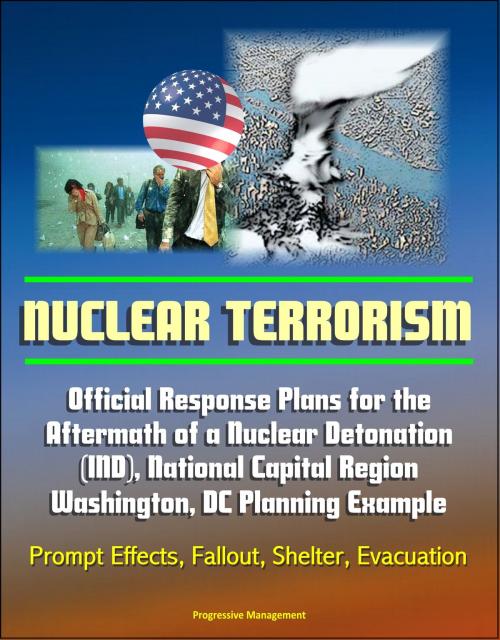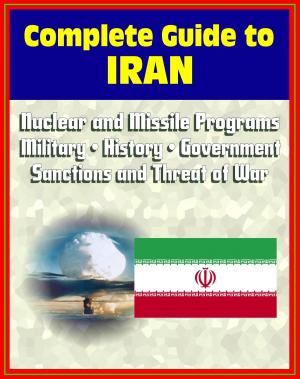Nuclear Terrorism: Official Response Plans for the Aftermath of a Nuclear Detonation (IND), National Capital Region, Washington, DC Planning Example - Prompt Effects, Fallout, Shelter, Evacuation
Nonfiction, History, Military, Nuclear Warfare, Social & Cultural Studies, Political Science| Author: | Progressive Management | ISBN: | 9781311330321 |
| Publisher: | Progressive Management | Publication: | September 5, 2014 |
| Imprint: | Smashwords Edition | Language: | English |
| Author: | Progressive Management |
| ISBN: | 9781311330321 |
| Publisher: | Progressive Management |
| Publication: | September 5, 2014 |
| Imprint: | Smashwords Edition |
| Language: | English |
The terrifying prospect of nuclear terrorism striking an American city is the subject of these two reports: National Capital Region: Key Response Planning Factors for the Aftermath of Nuclear Terrorism and Analysis of Sheltering and Evacuation Strategies for a National Capital Region Nuclear Detonation Scenario.
Contents of the NCR Response Report: Exposure - Recommended Public Actions, A Note About the Illustrative Scenario, Prompt Effects, Damage Zone (Blast Effects), Flash Blindness, Electromagnetic Pulse, Fires, Fallout, Close-in Exposure Concerns, Long-Range Exposure Concerns, Agricultural Embargo Areas, Fallout Properties, Fallout Zones, Shelter, Assessment of Modern Buildings, Regional Shelter Quality in the NCR, Evacuation, Regional Evacuation Assessment, Summary of All Strategies, Discussions and Recommendations, Emergency Management Priorities, Responder Priorities, Public Health and Medical Priorities, Long-Term Issues, Preparedness, Summary and Conclusions, Prompt Effects, Fallout, Shelter, Responder Protective Equipment and Equipment Settings, Injury Analysis and Medical Facility Impacts
Contents for Analysis of Sheltering Strategies: The Need for IND Response Planning * Earlier Studies * Goals of the National Capital Region (NCR) Analysis * Technical Approach * Analytical Framework and Key Assumptions * Modeling Shelter-Evacuate Strategy Effectiveness * Regional Shelter Quality * NCR Baseline Scenario - Regional Results * NCR Baseline Scenario and Evacuation Options * Regional Results - Sensitivities to Shelter Quality * Regional Results for Route-Based Evacuation Strategies * Regional Results for Shelter Transit Strategies * Regional Results Using NCR Svalin Data * NCR Scenario - Exemplary Point Analysis * Role of Exemplary Point Analysis * Exemplary Point Sensitivities - Cardozo High School * Implications of Exemplary Point Analysis * Key Findings and Recommendations
A low-yield explosion from an IND is quite different from Cold War strategic thermonuclear detonation scenarios upon which much of our current understanding and civil defense planning are based. Cold War recommendations provide some insights and advice; however, many of the former paradigms are no longer applicable and must be updated for modern cities and the nature of current threats. This report describes some common misconceptions about a low-yield nuclear detonation and explains important planning considerations.
Executive Summary: Execution of an appropriate sheltering and evacuation strategy following the detonation of a terrorist Improvised Nuclear Device (IND) in an urban area can save thousands of lives. These strategies can reduce the dose that many receive from the fallout radiation following the detonation, thereby minimizing the incidence of acute radiation sickness. Some of the best strategies can be implemented even in the confusion and disrupted communication environment that will likely follow such an event. However, prior planning and education of both response personnel and the affected population is necessary. Science-based information and federal guidance that supports planning for an urban IND event has become increasingly available in recent years. However, analyses that consider the key factors that are unique to specific urban areas are also important inputs to the planning process. Evaluations of alternative shelter-evacuate strategies following a 10 kT detonation in the National Capital Region have been completed. A range of strategies that include shelter-in-place, shelter transit, uninformed evacuation, and informed evacuation are included. In addition, a strategy that employs major official evacuation routes is evaluated. The prior planning and post-detonation requirements differ for each strategy. Each strategy is evaluated based on the total number of people in the region who are exposed to fallout radiation doses that would result in injury or death due to high total radiation doses.
The terrifying prospect of nuclear terrorism striking an American city is the subject of these two reports: National Capital Region: Key Response Planning Factors for the Aftermath of Nuclear Terrorism and Analysis of Sheltering and Evacuation Strategies for a National Capital Region Nuclear Detonation Scenario.
Contents of the NCR Response Report: Exposure - Recommended Public Actions, A Note About the Illustrative Scenario, Prompt Effects, Damage Zone (Blast Effects), Flash Blindness, Electromagnetic Pulse, Fires, Fallout, Close-in Exposure Concerns, Long-Range Exposure Concerns, Agricultural Embargo Areas, Fallout Properties, Fallout Zones, Shelter, Assessment of Modern Buildings, Regional Shelter Quality in the NCR, Evacuation, Regional Evacuation Assessment, Summary of All Strategies, Discussions and Recommendations, Emergency Management Priorities, Responder Priorities, Public Health and Medical Priorities, Long-Term Issues, Preparedness, Summary and Conclusions, Prompt Effects, Fallout, Shelter, Responder Protective Equipment and Equipment Settings, Injury Analysis and Medical Facility Impacts
Contents for Analysis of Sheltering Strategies: The Need for IND Response Planning * Earlier Studies * Goals of the National Capital Region (NCR) Analysis * Technical Approach * Analytical Framework and Key Assumptions * Modeling Shelter-Evacuate Strategy Effectiveness * Regional Shelter Quality * NCR Baseline Scenario - Regional Results * NCR Baseline Scenario and Evacuation Options * Regional Results - Sensitivities to Shelter Quality * Regional Results for Route-Based Evacuation Strategies * Regional Results for Shelter Transit Strategies * Regional Results Using NCR Svalin Data * NCR Scenario - Exemplary Point Analysis * Role of Exemplary Point Analysis * Exemplary Point Sensitivities - Cardozo High School * Implications of Exemplary Point Analysis * Key Findings and Recommendations
A low-yield explosion from an IND is quite different from Cold War strategic thermonuclear detonation scenarios upon which much of our current understanding and civil defense planning are based. Cold War recommendations provide some insights and advice; however, many of the former paradigms are no longer applicable and must be updated for modern cities and the nature of current threats. This report describes some common misconceptions about a low-yield nuclear detonation and explains important planning considerations.
Executive Summary: Execution of an appropriate sheltering and evacuation strategy following the detonation of a terrorist Improvised Nuclear Device (IND) in an urban area can save thousands of lives. These strategies can reduce the dose that many receive from the fallout radiation following the detonation, thereby minimizing the incidence of acute radiation sickness. Some of the best strategies can be implemented even in the confusion and disrupted communication environment that will likely follow such an event. However, prior planning and education of both response personnel and the affected population is necessary. Science-based information and federal guidance that supports planning for an urban IND event has become increasingly available in recent years. However, analyses that consider the key factors that are unique to specific urban areas are also important inputs to the planning process. Evaluations of alternative shelter-evacuate strategies following a 10 kT detonation in the National Capital Region have been completed. A range of strategies that include shelter-in-place, shelter transit, uninformed evacuation, and informed evacuation are included. In addition, a strategy that employs major official evacuation routes is evaluated. The prior planning and post-detonation requirements differ for each strategy. Each strategy is evaluated based on the total number of people in the region who are exposed to fallout radiation doses that would result in injury or death due to high total radiation doses.















